Durkan’s Test is a clinical assessment tool used to evaluate the likelihood of carpal tunnel syndrome, a common condition that causes pain, numbness, and tingling in the hands and fingers. This test involves the application of pressure to the carpal tunnel, a narrow passageway in the wrist, to determine if it is compressed or narrowed.
What is Carpal Tunnel Syndrome?
Carpal Tunnel Syndrome (CTS) is a widespread illness that affects millions of people throughout the world. It happens when the median nerve, which runs from the forearm to the hand, becomes compressed or pinched as it passes through the wrist’s carpal tunnel. This might result in discomfort, numbness, tingling, and weakening of the affected hand. Durkan’s test is a simple and reliable way to identify this condition.
Background and Development
Durkan’s test was first described in 1991 by Dr. John Durkan, a hand surgeon from Galway, Ireland. The test was developed to provide a simple and reliable way to diagnose carpal tunnel syndrome in a clinical setting. The test has since become a widely accepted tool for the diagnosis of CTS.
Explanation of the Physiology
The carpal tunnel is a narrow passageway in the wrist through which the median nerve and several tendons pass. Pressure on the median nerve can cause symptoms of carpal tunnel syndrome, such as tingling, numbness, and weakness in the thumb, index, middle, and ring fingers. Durkan’s test involves applying pressure to the carpal tunnel to assess for any symptoms of CTS.
How to Conduct Durkan’s Test
Before performing Durkan’s test, the patient should be in a comfortable sitting or lying position with their arm supported on a table or armrest. The test should be performed on both wrists to compare the results.
Steps Involved in Conducting Durkan’s Test
To conduct Durkan’s test, the examiner should apply moderate pressure with their thumb over the carpal tunnel in the wrist for 30 seconds. The pressure should be applied firmly enough to blanch the skin but not so much as to cause pain. The patient should be asked if they experience any tingling, numbness, or pain in the fingers during the test. The test should be repeated on the other wrist.
Interpretation of Durkan’s Test Results
Positive Durkan’s Test
The presence of tingling, numbness, or pain in the fingers throughout the 30-second test indicates a positive Durkan’s test. This implies that the median nerve, which runs through the carpal tunnel, has been compressed or inflamed. A positive Durkan’s test is a reliable sign of carpal tunnel syndrome (CTS) and, depending on the severity of the symptoms, may necessitate further diagnostic testing or therapy. As a result, healthcare providers must assess individuals who have a positive Durkan’s test for the presence of CTS.
Negative Durkan’s Test
A negative Durkan’s test, on the other hand, indicates the absence of symptoms during the test. A negative Durkan’s test, however, does not rule out the possibility of CTS. Patients with CTS may demonstrate symptoms despite a negative Durkan’s test in some situations. As a result, further testing or examination by a healthcare expert may be required to confirm or rule out the disease.
Clinical Significance
Overall, Durkan’s test is a straightforward and effective technique for diagnosing CTS. It can assist healthcare providers in identifying people who may require additional testing or treatment. Durkan’s test results which are positive are very clinically significant, indicating the presence of CTS and the necessity for additional examination. However, healthcare providers should be aware that a negative Durkan’s test does not rule out the occurrence of CTS, and patients presenting symptoms should be investigated further.
Difference Between Durkan’s Test Vs Phalen’s Test
Durkan’s test and Phalen’s test are both used to diagnose Carpal Tunnel Syndrome (CTS) and involve a physical examination of the wrist and hand. However, there are some key differences between these two tests.
| Test Name | Description | Positive Result | Sensitivity | Specificity | Wrist Position Required |
|---|---|---|---|---|---|
| Durkan’s Test | Pressure is applied to the carpal tunnel area for 30 seconds with the examiner’s thumb or finger. | Pain or paresthesia (tingling or numbness sensation) in the distribution of the median nerve. | 84% | 96% | Their wrist flexed for 60 seconds. |
| Phalen’s Test | The patient flexes their wrist and holds it in a bent position for 60 seconds. | Pain or paresthesia in the distribution of the median nerve. | 75-80% | 60-75% | Wrist flexed for 60 seconds. |
Advantages and Limitations
Durkan’s test is a medical diagnostic test designed to diagnose carpal tunnel syndrome. While the test is widely used in clinical settings, it has its own set of advantages and limitations.
Advantages
One of the primary advantages of Durkan’s test is its simplicity, making it easy to administer and interpret. The test involves applying pressure to the median nerve with the thumb, and if the patient experiences pain, it is an indication of carpal tunnel syndrome. Durkan’s test is also inexpensive, requires minimal equipment, and can be performed by a variety of healthcare professionals.
Limitations
One of the primary limitations of Durkan’s test is its low specificity. The test may produce false positives or negatives, making it challenging to diagnose carpal tunnel syndrome accurately. In addition, the test is subjective and relies heavily on the patient’s perception of pain, which can vary from person to person. Other factors like swelling, inflammation, and wrist fracture can also affect the results of the test.
Future Developments and Potential of Durkan’s Test
Durkan’s test has been in use for several years, and there is ongoing research to improve the test’s accuracy and reliability.
Research Trends and Developments
Recent research has focused on developing more objective measures of pain associated with carpal tunnel syndromes, such as using pressure algometry, vibration perception thresholds, and thermal pain threshold testing. Other studies are exploring the use of Durkan’s test in combination with other diagnostic tests to improve its predictive value.
Potential Applications of Durkan’s Test in the Future
The potential applications of Durkan’s test are vast. Future research may explore the use of the test in diagnosing other conditions affecting the median nerve or assessing pain levels in other areas of the body. Additionally, Durkan’s test may play a role in monitoring patients’ response to treatment or in predicting the likelihood of recovery. The continued research and development of Durkan’s test hold significant potential for improving the diagnosis and treatment of carpal tunnel syndrome and other conditions affecting the median nerve.
Conclusion
In conclusion, Durkan’s Test is a valuable tool in diagnosing carpal tunnel syndrome and has significant clinical applications. Its ease of use and cost-effectiveness make it an attractive option for healthcare providers. Despite its limitations, Durkan’s Test has potential for future developments and research that could enhance its accuracy and effectiveness in diagnosing various nerve compression syndromes.
FAQ
What does Durkan’s Test involve?
Durkan’s Test involves exerting pressure on the carpal tunnel in the wrist using the thumb, to determine if it is compressed or narrowed. The patient will be asked to report any pain, tingling, or numbness that is experienced during the test.
Is Durkan’s Test accurate in diagnosing carpal tunnel syndrome?
Durkan’s Test is a reliable screening tool for carpal tunnel syndrome, but it should not be used as the sole diagnostic tool. A comprehensive evaluation that includes a medical history, physical examination, and other diagnostic tests such as nerve conduction studies and electromyography is necessary for an accurate diagnosis.
Are there any risks associated with Durkan’s Test?
Durkan’s Test is a non-invasive and safe test that does not have any risks associated with it.
Are there any limitations to Durkan’s Test?
Durkan’s Test has some limitations, and false positives and false negatives can occur. False positives can happen if the test is performed incorrectly or if the patient has conditions that can mimic carpal tunnel syndrome. False negatives can occur if the test is not performed correctly or if the patient has a mild case of carpal tunnel syndrome.
Latest Posts
- Premenstrual Syndrome (PMS) Explained: Powerful Relief Strategies for 2026

- Magnetic Seizure Therapy (MST): A Breakthrough in Psychiatric Treatment in 2025

- AIIMS New Delhi, NIMHANS Bengaluru, JIPMER Puducherry: No Leaves for Healthcare Workers Amid Tensions

- Narcissistic Personality Disorder in 2025: Unveiling the Hidden Struggles and Empowering Recovery

- Conquering Rubral Tremor: Unveiling Effective Treatments in 2025

